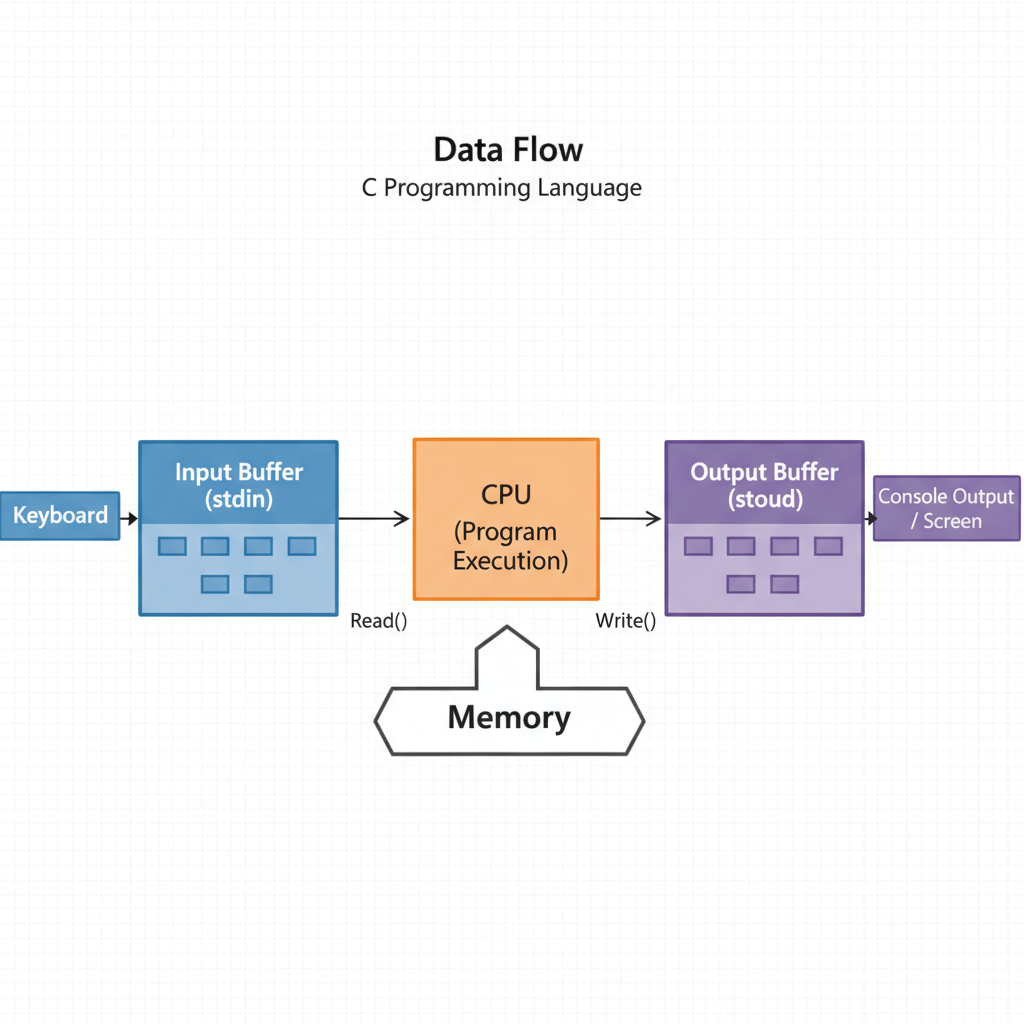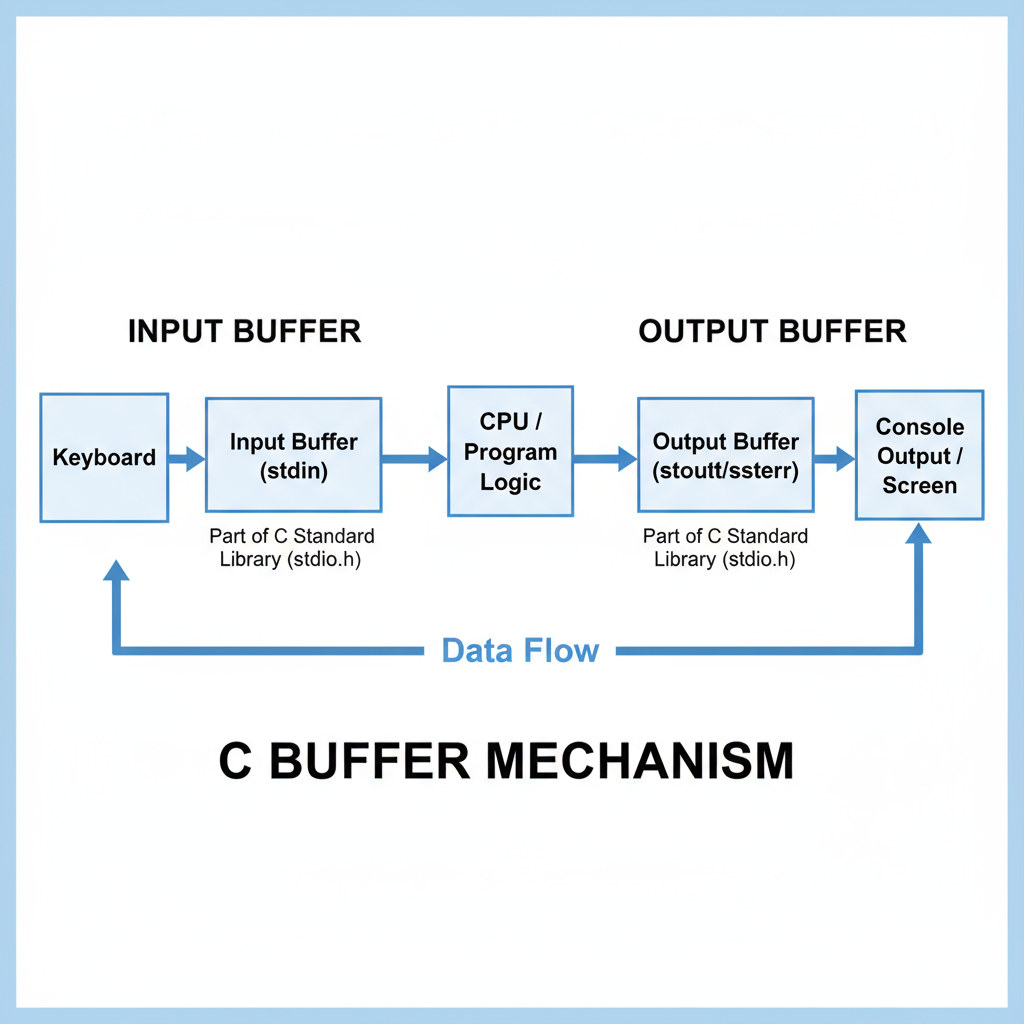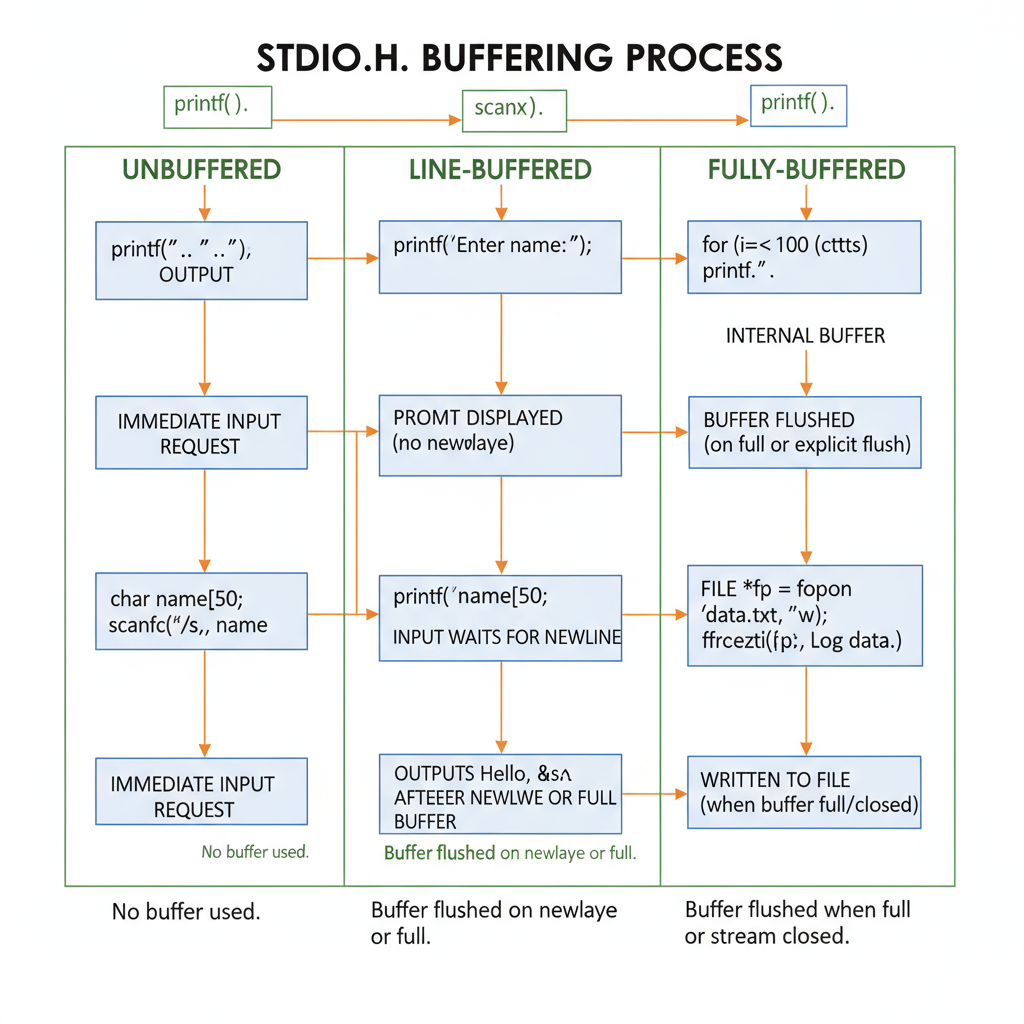Buffer C in C Programming Explained with Examples
Learn how buffers work in C programming, including input vs output buffering, stdio control functions, and buffering modes for efficient I/O.

Introduction to Buffers in C Programming
In C programming, a buffer is a reserved block of memory used to temporarily store data as it moves between locations. Buffers are vital for maximizing efficiency in both input and output (I/O) operations by reducing slow, direct hardware access. This buffering mechanism synchronizes data flow between different system components, ensuring that varied processing speeds do not compromise application performance.

Whether handling keyboard input, reading from files, or printing to the console, understanding buffers in C helps developers write faster, safer, and more resource‑efficient software.
---
Buffers in the C Language Context
In C, standard I/O functions from ``—such as `printf()` or `scanf()`—operate on buffers behind the scenes:
- Keyboard input is stored in an input buffer before the program reads it.
- Program output is often placed in an output buffer before being displayed.
This design minimizes expensive system calls and enhances performance by batching I/O operations instead of executing them character by character.
---
Input Buffer vs. Output Buffer in C
C supports two main buffer categories:
| Buffer Type | Description | Example |
|---|---|---|
| Input Buffer | Temporarily holds incoming user or file data before program processing | Key presses stored until Enter is pressed in `scanf()` |
| Output Buffer | Temporarily stores program output before device display or file write | `printf()` output shown after newline or flush |
Recognizing the difference is important, as each buffer type flushes under different conditions, affecting output timing and program responsiveness.
---
How Standard I/O Buffering Works (`stdio.h`)
The `` library implements a buffered I/O strategy:
- Each I/O stream (`stdin`, `stdout`, `stderr`) gets its own buffer.
- Data accumulates in the buffer until specific triggers cause a flush (data written to or read from the device).
- Flushing occurs on events like newline characters, buffer fill, manual `fflush()` calls, or program termination.
This model improves efficiency by minimizing costly read/write operations at the operating system level.
---
Using `setbuf()` and `setvbuf()` for Buffer Control
C allows customization of buffer behavior:
- `setbuf(FILE stream, char buffer)`
- Assigns a specific buffer to a stream or disables buffering when buffer is `NULL`.
- `setvbuf(FILE stream, char buffer, int mode, size_t size)`
- Offers more control, letting developers specify modes and sizes.
Example:
#include
int main() {
char buf[BUFSIZ];
setvbuf(stdout, buf, _IOFBF, BUFSIZ); // Full buffering
printf("This will be buffered.\n");
return 0;
}
---
Buffering Modes in C
There are three buffering strategies:
| Mode | Description | Macro |
|---|---|---|
| Full buffering | Data accumulates until buffer is full | _IOFBF |
| Line buffering | Flushes at newline or when buffer is full | _IOLBF |
| No buffering | Data output immediately without delay | _IONBF |
Typical usage includes full buffering for file I/O, line buffering for console output, and no buffering for error streams like `stderr`.
---
Buffering and `printf()` / `scanf()` Behavior
For `stdout` (line buffered by default):
- Flushed when:
- Writing a `\n`
- Buffer full
- Program ends normally
- Calling `fflush(stdout)`
For `stdin` (input buffering):
- Data gathers until Enter is pressed.
- `scanf()` reads from the buffer, leaving unprocessed characters if format specifiers don't match all input.
---
Use Cases Where Buffering Improves Efficiency
Buffering is crucial in:
- File I/O – Reduces disk head movements and read/write calls.
- Network Transfers – Batches packets, improving throughput.
- Batch Logging – Writes multiple log entries in a batch, reducing file operations.
In each case, buffering minimizes processing delays and resource usage.
---
Potential Problems Caused by Buffering
However, buffering can create challenges:
- Delayed Output – May hinder debugging if output is seen late.
- Data Loss – Program crashes before flushing can result in missing data.
- Mixed I/O Issues – Mixing buffered/unbuffered I/O on the same stream can cause inconsistencies.
Understanding flush points avoids these pitfalls.
---
Manual Buffer Flushing Using `fflush()`
To ensure immediate output:
#include
int main() {
printf("Processing...");
fflush(stdout); // Display immediately
// Simulate long operation...
printf("Done!\n");
return 0;
}`fflush()` is essential for interactive applications where timely user feedback is critical.
---
Security Implications of Buffer Mismanagement
Improper handling can lead to:
- Buffer Overflow – Exceeding buffer boundaries risks crashes or exploits.
- Information Leakage – Uninitialized buffers may expose sensitive data.
- Race Conditions – Unsynchronized buffer access in multithreaded programs creates instability.
Applying strict boundary checks and safe functions reduces these risks.
---
Best Practices for Handling Buffers Safely in C
- Size Buffers Suitably – Anticipate data volume.
- Validate Inputs – Protect against overflow.
- Use Safe Functions – Prefer `fgets()` over `gets()`.
- Flush When Needed – Especially in user‑interactive scenarios.
- Avoid Mixed I/O – Prevent desynchronization by maintaining consistent usage.
---
Debugging Tips: Detecting Buffer-related Errors
To track down buffer issues:
- Enable Compiler Warnings (`-Wall`, `-Wextra`)
- Use Tools – Memory checkers like Valgrind detect errors.
- Strategic Printing – Insert selective `fflush(stdout)` for visibility during debugging.

Testing against unusual and extreme inputs can also reveal subtle bugs.
---
Conclusion and Next Steps
In C programming, buffers are indispensable for fast, efficient I/O. From understanding input and output buffers, to customizing modes with `setbuf()`/`setvbuf()`, to strategic flush management, mastering buffers optimizes performance and safeguards reliability.
Key Takeaways:
- Buffers minimize direct device access for speed.
- Select suitable buffering modes per use case.
- Safe handling prevents security exploits.
Further Learning:
- C Standard Library `` Reference
- The C Programming Language by Kernighan & Ritchie
- GNU C Library Documentation
Leverage buffer knowledge to write C programs that are not only faster and more stable but also more secure—start applying these techniques to your projects today.




